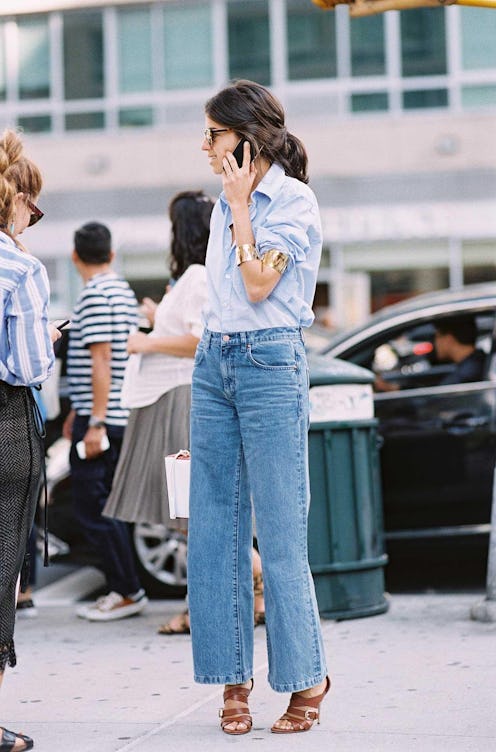There’s no two ways about it: It’s an interesting time to be a denim brand. Emphasis on the word “interesting.” On one hand, denim has never been more pervasive and relevant (see Pharrell showing up in denim to be honored by the CFDA and the recent Resort collections). On the other, sales have reportedly been down for the last several years (jean sales in the US declined eight percent last year), thanks in no small part to the rising popularity of the athleisure trend and its requisite yoga-pants uniform. There are also environmental concerns in terms of the amount of water denim production requires. It all begs the question: Has the blue jean—first made popular by cowboys in the American West—seen its day and riding off into the sunset or is its true heyday still on the horizon?
Who better to ask than Karyn Hillman, Chief Product Officer for Levi’s, perhaps the industry’s most iconic brand: “From Levi’s point of view, it’s an excellent time to be in the denim industry. There’s a strong return to authenticity in denim,” she says. “There’s a great balance between tradition and new technology. We’re pioneering a lot of innovations, including amazing new fabrics which we’ve used to relaunch our women’s jeans this fall [available July 8]. These advancements paired with our 140-plus years of history make our brand unique, in a time when there’s so much to chose from.” And perhaps that’s part of the issue: There is so much to choose from. Sure, there are brands synonymous with jeans itself, like Levi’s of course and other, popular modern lines including J.Brand, 7 For All Mankind, Current/Elliott, Citizens of Humanity and countless (literally countless) others. Then there are the highest-end designers who have also—in a somewhat surprising turn—gotten into the denim game (Stella McCartney, Chloe, Gucci, Saint Laurent and recently Givenchy among them), sending styles in the all-American fabric down major runways. So how does one stand out in a market so saturated and so competitive?
Levi’s Chief Product Officer Karyn Hillman Photo Courtesy: Levi’s
“In order to stand out in the increasingly saturated market, a denim company needs to focus on building a brand—one that is distinct in its product aesthetic, branding and marketing,” says Emily Current, who along with her business partner Meritt Elliott, created the brand Current/Elliott, wrote the book A Denim Story and is now cofounder/codesigner of the duo’s new line, The Great. “Rather than participating in every trend happening in the market, it’s about choosing when and if it’s appropriate for your brand.”
Stylists, designers and denim experts Meritt Elliott and Emily Current. Photo: Mi and Mo Photography
Hillman agrees, with this many brands competing for the spotlight and customers, it’s important to not try to be all things to all people. “All truly great brands have a clear and consistent identity,” she says. “The temptation is always there to try to please everyone all the time, but you can dilute your brand identity if you do so.” For an increasingly popular brand like Mother denim, that distinctness has come in the form of high-profile collaborations with supermodels, including Candice Swanepoel and Freja Beha. “We love to have the input of different people in the industry we respect, like Candice and Freja,” says cofounder Lela Rose Becker. “Their perspective allows us to offer styles and fabrics for the capsule lines that are their take on denim. So much style direction these days comes from street style, and the models are a big part of that vibe.”
Candice Swanepoel in pieces from her Mother collaboration. Photo: Russell James
The launched-last-year brand Re/Done has a different approach to establishing its unique voice, taking what is already there (vintage Levi’s) and reworking them almost completely to update and modernize the fit. The concept was so well-received the 50 pairs they launched with sold out immediately. It’s not only a more environmental approach (the company saves on average 2,500 gallons of water per jean produced vs. making a new pair), it also proves that sometimes it isn’t necessary to reinvent the wheel to stand out from the crowd. “We tapped into what is happening today,” says founder and CEO Sean Barron. “There is a new appreciation for the long-term value of things. People don’t want to feel like one of the masses, they want individuality. We don’t believe this is a trend—we believe it’s a movement, one we are proud to be part of.”
Vintage Levi’s repurposed into Re/Done pieces. Courtesy: Re/Done
And therein may lie the answer. Perhaps in the wake of normcore and the tidal wave that is fast fashion, consumers are really just seeking authenticity—something with more history than the yoga legging but less trend driven than the culotte. “There’s been a great return to simple, authentic denim jeans,” says Hillman, “and we’ve seen that influence on the fashion industry, with vintage 501s becoming the denim of choice for everything from editorial spreads to front row at Fashion Weeks across the globe.” In fact, signs point to a resurgence for the fabric—if a small one—as sales have been showing a slight increase as of late.
It seems the denim industry may be just as tough as the fabric it’s centered around—able to take a few beatings but ultimately all the better for it. “Denim is an icon in American and international fashion,” says Barron. “It will always play a significant role in the fashion industry.”
